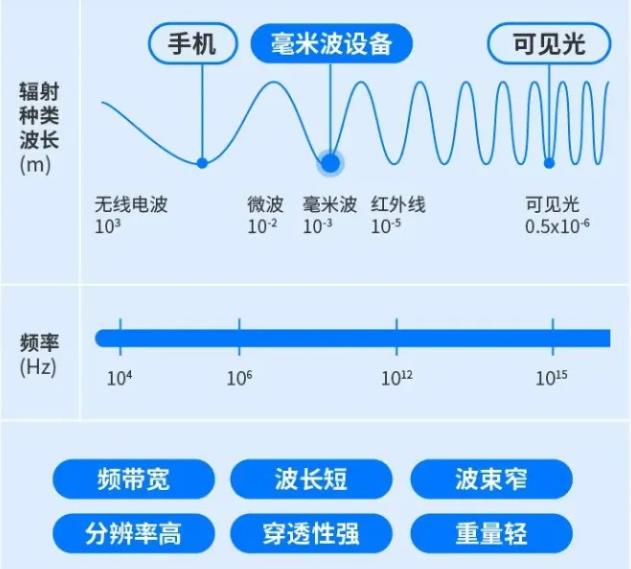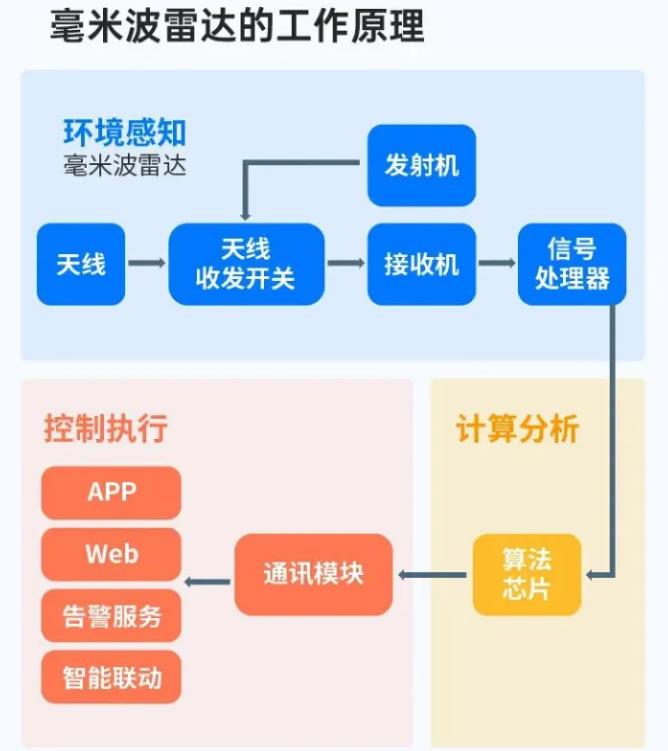To talk about the hottest technology in the past two years, millimetre wave radar definitely counts as one. In these two years, millimetre wave radar frequently fire out of the circle, the major enterprises have embraced millimetre wave. Automatic driving, smart home, health monitoring, smart city, smart buildings and other industries have appeared in its figure. What is millimetre wave radar and what changes can it bring to our lives?
What is millimetre wave radar?
Millimetre wave is an electromagnetic wave between microwave and light wave, with a frequency band of 30-300 GHz and a wavelength of 1-10 mm. In addition, although the common 24 GHz electromagnetic wave does not belong to millimetre wave, its propagation characteristics are very similar to millimetre wave, so it is often treated as a millimetre wave for research and use.
Millimetre wave radar has the characteristics of wide bandwidth, short wavelength, narrow beam, light weight, strong resolution and strong penetration, etc. Compared with microwave, millimetre wave radar is more powerful than microwave. Compared with microwave, millimetre wave radar has high resolution and lightweight structure; compared with infrared and visible light, millimetre wave radar is more penetrating and less affected by climate, which can ensure normal detection in rain, snow, storm, smoke and dust and other adverse environments, and it has the characteristics of all-weather and full-time work.
It can be said that it is a collection of a hundred strengths, these advantages make millimetre wave radar in the missile guidance, car collision avoidance, helicopter collision avoidance, anti-terrorism security check, millimetre wave medical treatment and other fields to show their skills.

What are millimetre waves?
Operating Principle of Millimetre Wave Radar
The antenna transmits electromagnetic waves, which are reflected back by the target. Using the reflected electromagnetic waves, amplification and signal analysis can calculate the distance of the object and the distance between left and right objects by combining different azimuth angles. By using the Doppler effect, the distance, speed, angle and direction of the moving object can be calculated.

Operating Principle of Millimetre Wave Radar
Development of Millimetre Wave Radar
1.Budding Development (1940-1979)
Millimetre wave radar is not a new technology, it has been in existence since 1940. It was first used in marine navigation, but due to its low power and high transmission loss,its development was greatly restricted.
In the mid-70s, the German companies AEG-Telefunken and Bosch began to inject funds into the research of millimetre-wave radar in the car collision avoidance applications,due to the expensive cost, and then there was no further, the development of millimetre-wave radar came to a standstill.
2.Technology explosion period (1980-1989)
In the early 80's, many famous universities, research institutes and enterprises around the world joined in the research of millimetre-wave radar,which directly promoted the development of millimetre-wave technology by leaps and bounds. In the late 80's, the “European Efficient and Safe Traffic Systems Project” started the research programme of in-vehicle millimetre wave radar again.
3.Commercialisation (1990-2012)
In the 1990s, millimetre wave radar automotive collision avoidance technology gradually matured, and millimetre wave radar products were gradually applied in the automotive field. In 1999, Mercedes-Benz took the lead in applying 77GHz millimetre wave radar to the autonomous cruise control system.
4.Rise of Chinese products (2013-present)
In 2013, 24 GHz millimetre wave radar entered the Chinese market, and 77 GHz millimetre wave radar implemented a technology blockade. China started its own exploration on millimetre-wave radar, and a large number of pioneering millimetre-wave radar entrepreneurial enterprises emerged, increasing the research and development of millimetre-wave radar. China's millimetre-wave radar has risen with great efforts and made great breakthroughs, realising the mass production of commonly used millimetre-wave radar. It is believed that with the maturity of technology and cost reduction, millimetre-wave radar will make greater breakthroughs.
Millimetre wave radar applications
Millimetre wave radar was mainly used in military, specialised applications and automobiles in the early days, and then gradually turned to the smart home and became a civilian consumer electronic product. From military to civilian, from the automotive field to the smart home field, millimetre wave radar flew into the ordinary people's homes, military high-tech devolution of civilian life field, millimetre wave radar can be said to be the downsizing impact.
According to the working frequency band, there are three types of millimetre wave radar in the civilian market - 24 GHz millimetre wave radar, 60 GHz millimetre wave radar and 77 GHz millimetre wave radar. 24 GHz is the first millimetre wave radar to be used in civilian applications, and it is also the most mature in terms of technological development.
Based on the application of 24 GHz and 60 GHz millimetre wave radar, some millimetre wave radar companies have launched various millimetre wave radar series such as human body sensing radar, fall care radar and sleep care radar.
Human body sensing radar adopts 24GHz millimetre wave, which can accurately sense the presence of human body. Compared with traditional infrared sensors, it has higher sensing accuracy, is not affected by the environment, and remains accurate and stable at all times.
Human body sensing radar has three sensing functions: human presence sensing, light and dark sensing, and human movement amplitude sensing. High-precision human presence detection, blink of an eye can be sensed accurately, and continuously detect the presence of people in the space.

Millimetre wave radar applications
In addition to security detection, it can also intelligently adjust the lighting according to the brightness of the ambient light, so that no one will ever be embarrassed to play with his mobile phone on the sofa when the sensor light suddenly goes out. Support whole-house smart home linkage, according to the room occupied/unoccupied, linkage control lighting, air conditioning, sweeper, speakers and other intelligent devices, customised comfort and convenience of intelligent life scene.
Fall detection radar adopts 60GHz millimetre wave radar, which provides intelligent fall detection and alarms to ensure the safety of the elderly in real time. High-precision intelligent fall recognition algorithm, fall recognition rate of over 95%, can accurately determine the fall, fall out of bed and other dangerous behaviours, and automatically make phone calls and APP push messages for help.
In addition to common fall postures, it can also recognise slow falls, falls against the wall, semi-sitting falls, squatting falls and other low-posture falls. Installed in the bathroom, the elderly will be alarmed if they stay in the bathroom for more than the set time, preventing the elderly from having accidents in the shower. No contact detection, no invasion of privacy, no need to wear on the body, full-time guarding the elderly well-being.
Now you have an understanding of millimetre wave radar? Through the previous introduction, we know that the biggest advantage of millimetre wave radar is that it is accurate, does not violate privacy, and can work around the clock.
Millimetre wave radar has a wide range of application prospects, and we believe that with the arrival of the 5G era and the development and maturity of millimetre wave technology, millimetre wave radar will really enter our ordinary life, bringing people a beautiful, convenient, safe and healthy smart life experience.